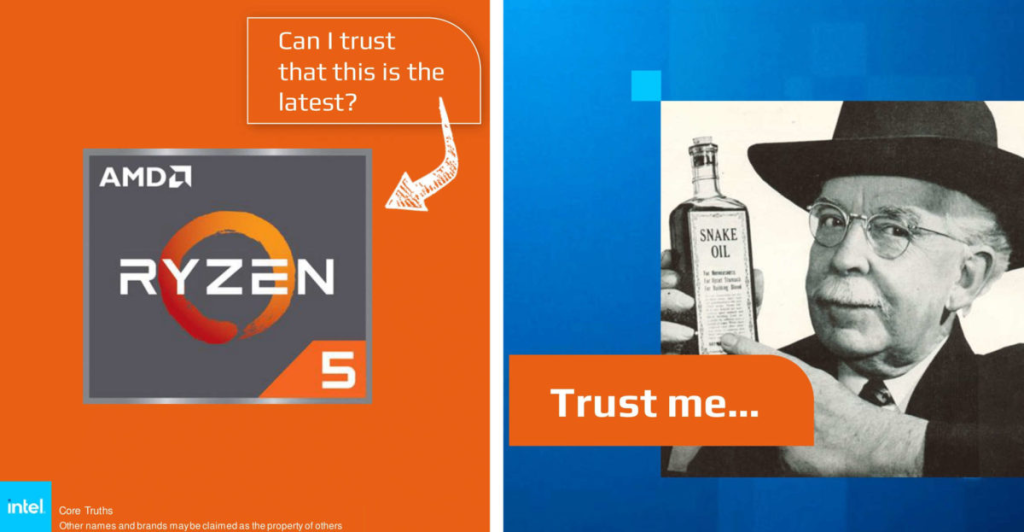Office Address
S.C Chatterjee Road - Bandel
Prantik Benepukir
IN - West Bengal
Hooghly - 712123
Core Truths: We take away features from you, give you a worse price for performance products, and we blame AMD for letting us do that.

Intel recently released a presentation titled “Core Truths” to shed light on the intricacies of the latest CPU technologies. The presentation seems to suggest that AMD’s latest series may include older architecture, marking a significant shift in Intel’s approach. This is reminiscent of Intel’s confrontational EPYC glue campaign against AMD, a strategy both companies have since avoided to maintain positive customer sentiment.
The presentation reveals three key ‘truths’. The first one points out that the AMD Ryzen 5 7520U mobile processor is based on the Zen2 architecture. AMD had revamped its naming convention for the Ryzen 7000 series before launching the new Zen4 mobile lineup. This strategy involved including various microarchitectures within a new product stack. In this scheme, ‘7’ represented 2023 products, paving the way for the upcoming ‘8xxx’ to denote processors scheduled for 2024. The third digit was used to identify the architecture, with ‘2’ for Zen2, ‘3’ for Zen3, and ‘4’ for Zen4. As a result, the expected Zen5 series, named Strix Point, should logically adopt the nomenclature Ryzen 8050.

The second ‘truth’ in the presentation implies that AMD is incorporating older architectures into its products. This is evidenced by the AMD Ryzen 7000 product naming convention, which explicitly states the inclusion of Zen2.
AMD later launched the Mendocino series, aimed at a budget-friendly segment of lightweight laptops. These processors were built using the Zen2 architecture combined with RDNA2 graphics. The Ryzen 5 7520U, part of the 7000 series, was specifically targeted by this marketing campaign.

Intel argues that relying on Zen2 may not provide the same level of experience and performance as newer architectures. To substantiate this claim, the presentation includes direct CPU comparisons, particularly focusing on the low-end mobile segment. The Core i5-1335U is used as an example in the comparison.
While the AMD Ryzen 7000 naming scheme can be confusing, it does at least confirm the microarchitecture directly, unlike Intel’s series. It’s worth noting that the 14th Gen Core series is based on the refreshed Raptor Lake series. There are also indications that the upcoming Core 100 series will incorporate the Raptor Lake Refresh series for laptops. Yes, we are allowed to refresh, without a node shrink, AMD can’t do it. Cringes in Ice Lake.

It’s disheartening to see Intel’s approach to innovation in recent years. The company’s decision to withhold the Dynamic Application Optimization (APO) feature from the 13th and 12th generations, despite them having the same Gracemont E-cores, feels like a missed opportunity, and when review outlets asked about it, blatantly denied offering any support, even tho it is possible, using process lasso and reducing the performance penalty. This, coupled with the continued refresh of the 14nm process over five generations, raises questions about the company’s commitment to technological advancement.
The release of the Rocket Lake 11900K, which was criticized for its high power consumption and lackluster multi-threaded performance, further exacerbates these concerns. The fact that the Raptor Lake CPUs are essentially an enhancement of the 12th generation and the 14th generation is merely a refresh of the 13th, suggests a lack of substantial progress.

While Intel remains a significant player in the tech industry, these decisions could potentially undermine consumer trust and confidence in the brand. The company must demonstrate a clear and innovative roadmap for its future generations of CPUs to maintain its competitive edge in the market.
The full slide is presently taken down by Intel, a path certainly taken in the right direction, but the damage is already done. It’s clear that the competition between AMD is heating up. The AMD Ryzen 7 5800X3D’s performance has reportedly surpassed that of the Intel Core i9-14900K, which might have put Intel in a challenging position.
This could be seen as a wake-up call for Intel, prompting them to reassess their strategies and product offerings. If this wasn’t enough copium, the 7800x3d beats everything they have to offer when it comes to performance, as well as power draw. So Snake Oil, Who’s laughing now? It’s clean and simple, Ryzen7000 Is superior.